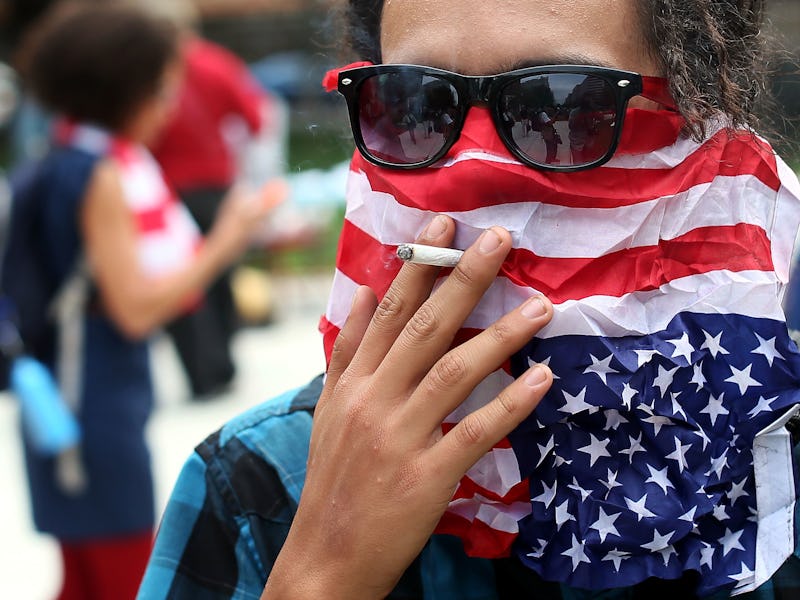Public Housing Is the Next Battlefront for Smoking Bans
A new proposal by the Department of Housing and Urban Development would make lighting up illegal for all residents.

A new rule proposed by the Department of Housing and Urban Development, would make it illegal for residents to smoke cigarettes within 25 feet of publicly owned or subsidized residential units, including office and administrative spaces and outbuildings. While 228,000 of the nation’s public housing units already have voluntarily smoking bans in place, the new law would make smoking bans mandatory in more than 700,000 units nationwide.
Governments on the federal, state, and local levels have already moved to ban smoking in public places, including government office buildings, schools, and parks. Eighty percent of Americans already live in areas under smoking bans on privately owned property like bars and restaurants, and some cities and counties have even moved to ban smoking in cars where minors are present and private residences.
U.S. Secretary of Housing and Urban Development Julian Castro
HUD Secretary Julian Castro trumpeted the proposed ban in a November statement:
“We have a responsibility to protect public housing residents from the harmful effects of secondhand smoke, especially the elderly and children who suffer from asthma and other respiratory diseases.”
It is fair to say we are well past the debate on whether or not cigarette smoke is harmful. Even if you don’t believe the U.S. landed on the moon or that jet fuel can melt (or, for chrissakes, just weaken) steel beams, chances are you will acknowledge that cigarette smoke is bad for you and those around you. The Surgeon General estimates that nearly half a million Americans die each year because of tobacco smoke, that more than 16 million people suffer from a smoking-related disease, and that the direct medical costs of smoke-related maladies run $130 billion a year.
On its face, the smoking ban seems like a no-brainer. Some 8.7 million Americans live in publicly owned or subsidized housing, including 3.3 million minors. And while smoking rates have steadily decreased during the past three decades, and the CDC estimates that 17 percent of adults are regular smokers, about 26 percent of adults living below the poverty level smoke. They are, of course, the majority of people living in public housing.
Yet the proposed ban has been met with some compelling arguments (“Obama Loves Gangbangers” certainly not among them). Libertarian-minded Americans don’t believe it’s the government’s business to nanny citizen’s personal behaviors, for one — does the government have the right to tell people what they can’t do in their own homes? Most readily acknowledge that smoking is harmful, but as the slippery slope argument goes, if the government can ban smoking in public owned or subsidized homes, what’s to prevent other in-home bans?
Further, civil-rights advocates worry that enforcing the ban might result in harsh consequences for already disenfranchised people. Public housing residents are disproportionately women, minorities, and almost by definition, poor. Rules that allow for low-income residents to be evicted for non-compliance — especially for something as hard to prove as smoking — could result in the new rules being used as a cudgel for renter intimidation or ultimately eviction that might have previously been considered unlawful. Are you really going to kick poor people addicted to nicotine to the curb? Will you fine them? These aren’t insignificant questions.
Perhaps the most compelling argument is from housing authority officials and lawyers themselves who support the concept of prohibiting smoking. In practice, however, they worry the new mandatory policies won’t do much to reduce smoking rates in units, will be almost impossible to enforce, and will add millions of dollars in extra administrative and legal costs to already over-extended budgets. They point to ineffective attempts in states like Florida where low-income residents are required to submit mandatory drug tests for public assistance; the program costs the state millions of dollars (including almost $2 million dollars in fees defending legal challenges).
A cigarette break outside a public housing building in New Jersey
It’s important to point out that while studies have shown smoking bans do reduce the number of smokers, the main goal of prohibiting smoking in and around publicly owned or subsidized residences is primarily to reduce exposure to secondhand smoke. More than 50,000 non-smokers die each year because of exposure to secondhand smoke, and HUD estimates just banning smoking in its units could save well over $50 million per year in smoke-related damage and averted fire loss. Research shows that even the most advanced indoor air filtration systems don’t completely remove secondhand smoke. A ban would curtail smokers’ liberties. It would also prevent fires and children’s asthma. So whose freedoms win here?
In most states, landlords of privately owned rentals already have the legal right to ban smoking on the premises. Theoretically, when it comes to fully publicly owned housing, the government could assert the same landlord-tenant rights as private owners. The waters get murkier when the government is subsidizing payments to private owners. A mandatory smoking ban overrides the property owner’s choice on how to manage their own property.
With the 60-day window for public comment soon closing, it looks like there is a pretty good chance the new HUD requirements will go into effect sometime in the next 18 months. A push to eliminate cigarette smoking is a noble one; we know that cigarette smoke is dangerous to the smoker and everyone around them. However, when the new rules are adopted, expect a legal fight over whether ending smoking indoors is a matter of government regulation or personal responsibility.